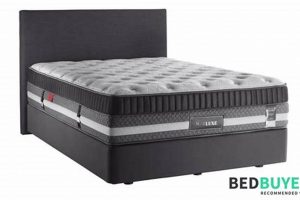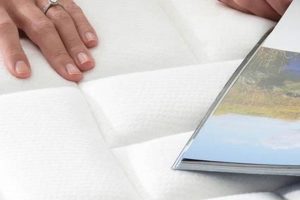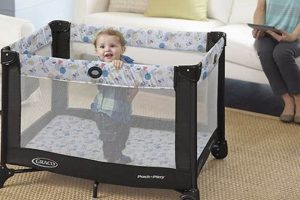The primary consideration for safe and comfortable sleep environments for infants in portable cribs involves selecting a suitable sleeping surface. This surface directly impacts the childs rest quality and overall well-being during periods spent in the portable crib.
A proper sleeping surface provides crucial support, promoting healthy spinal alignment and mitigating potential risks associated with inadequate support. Historically, caregivers have sought solutions balancing portability with the critical need for a safe and supportive sleep environment for infants. The availability of well-designed options addresses the growing demand for enhanced comfort and safety features.
This article will explore the key aspects involved in choosing appropriate sleeping surfaces for portable cribs, including safety standards, material considerations, size compatibility, and features contributing to enhanced sleep quality for the child.
Guidance for Selecting a Suitable Sleeping Surface for Portable Cribs
The selection of a suitable sleeping surface is paramount to ensuring infant safety and comfort within a portable crib environment. The following guidance outlines critical considerations for informed decision-making.
Tip 1: Adherence to Safety Standards: Verify that the selected sleeping surface meets or exceeds current safety regulations established by organizations such as the Consumer Product Safety Commission (CPSC). Compliance ensures the product has undergone rigorous testing for harmful substances and construction integrity.
Tip 2: Precise Dimensional Compatibility: Confirm that the dimensions of the sleeping surface precisely match the interior dimensions of the portable crib. Gaps between the sleeping surface and the crib’s sides pose a significant entrapment hazard.
Tip 3: Optimal Firmness Level: Choose a sleeping surface with sufficient firmness to provide adequate support for the infant’s developing musculoskeletal system. Soft surfaces increase the risk of suffocation and are not recommended.
Tip 4: Hypoallergenic and Non-Toxic Materials: Prioritize sleeping surfaces constructed from hypoallergenic and non-toxic materials. Infants are particularly susceptible to sensitivities and allergic reactions to certain chemicals and substances.
Tip 5: Water-Resistant and Easily Cleanable Surface: Select a sleeping surface with a water-resistant or waterproof cover. This feature simplifies cleanup in the event of spills or accidents and helps maintain a hygienic sleep environment.
Tip 6: Adequate Air Circulation: Consider sleeping surfaces designed to promote airflow. Breathable materials can help regulate the infant’s body temperature and reduce the risk of overheating.
Tip 7: Durability and Longevity: Assess the overall construction quality and materials to ensure the sleeping surface will withstand regular use and cleaning without compromising its integrity or support.
Careful consideration of these factors when choosing a portable crib sleeping surface is essential for promoting infant safety, comfort, and healthy development.
The following sections will delve into specific material types and features to further aid in the selection process.
1. Firmness
Firmness is a critical determinant of the suitability of a mattress for a portable crib. The relationship between firmness and infant safety is direct and consequential. Insufficient firmness in a mattress elevates the risk of Sudden Infant Death Syndrome (SIDS) and suffocation. Infants lack the motor skills to reposition themselves effectively if their faces become pressed against a yielding surface, potentially obstructing their airways. Therefore, a mattress deemed suitable for a portable crib must possess adequate firmness to mitigate this risk. For example, mattresses marketed as “extra soft” or “plush” are generally unsuitable for infant use, irrespective of their other features.
The firmness of a mattress is not merely a matter of comfort; it is a safety feature. Mattresses intended for portable cribs are subjected to specific firmness standards established by regulatory bodies. These standards aim to ensure the mattress provides sufficient support to prevent indentation under the infant’s weight. A practical example of this requirement is the “finger test,” where a caregiver applies pressure to the mattress surface. If the indentation is excessive or slow to recover, the mattress is deemed insufficiently firm. Furthermore, the type of material used in the mattress construction significantly influences its firmness. High-density foam and certain coil-spring designs are frequently employed to achieve the necessary firmness levels while maintaining acceptable levels of comfort.
In summary, firmness is a non-negotiable characteristic of a safe mattress for a portable crib. Adherence to established firmness standards is paramount, overriding considerations of perceived comfort. Understanding the practical implications of mattress firmness empowers caregivers to make informed decisions, prioritizing infant safety above all else. Ignoring this critical attribute can have severe, potentially fatal, consequences.
2. Size Compatibility
Size compatibility is an indispensable attribute of a suitable mattress for portable cribs. A correctly sized mattress directly mitigates risks associated with entrapment and suffocation. A mattress that is too small leaves gaps between its edges and the crib’s frame. These gaps present a hazardous scenario where an infant can become wedged, potentially leading to restricted breathing or even death. Conversely, a mattress that is too large may buckle or warp, creating an uneven sleeping surface, compromising support, and increasing the risk of positional asphyxia. An example illustrates this necessity: A standard portable crib interior measures approximately 24 inches wide by 38 inches long. A mattress intended for use within such a crib must adhere to these dimensions with minimal deviation to ensure a safe and secure fit.
The consequences of mismatched sizes extend beyond immediate physical hazards. Inadequate size compatibility can also undermine the intended functionality of the portable crib. For instance, if a mattress is significantly smaller than the crib’s base, it may shift during the infant’s movements, disrupting sleep and potentially contributing to developmental issues related to inadequate rest. Furthermore, repeated adjustments or repositioning of an improperly sized mattress can compromise the structural integrity of the crib itself, accelerating wear and tear and potentially voiding warranty coverage. Therefore, adherence to precise dimensional specifications is not merely a matter of convenience but a critical component of maintaining a safe and reliable sleep environment for the infant.
In conclusion, size compatibility r
epresents a non-negotiable criterion in the selection of a mattress for a portable crib. The repercussions of neglecting this aspect can range from minor sleep disturbances to life-threatening situations. Caregivers must prioritize accurate measurements and verification of product specifications to ensure a secure and appropriate fit. This diligence safeguards the infant’s well-being and maximizes the intended utility of the portable crib, promoting restful and safe sleep experiences.
3. Material Safety
Material safety is a foundational pillar in the context of a portable crib mattress. The direct contact an infant has with the mattress surface for extended periods necessitates rigorous scrutiny of the materials used in its construction. The selection of safe materials mitigates the risk of exposure to harmful chemicals, allergens, and irritants that can negatively impact infant health and development. Failure to prioritize material safety can result in skin irritation, respiratory issues, and potential long-term health consequences due to the absorption of volatile organic compounds (VOCs) and other toxins. For instance, a mattress containing phthalates, flame retardants, or heavy metals poses a significant risk to the infant’s endocrine system and neurological development. In considering a mattress, one must assess certifications, material composition, and manufacturing processes to verify its safety.
Specific examples of materials considered safe for infant mattresses include organic cotton, natural latex, and CertiPUR-US certified foams. Organic cotton reduces exposure to pesticides and herbicides used in conventional cotton farming. Natural latex offers inherent hypoallergenic properties and resistance to dust mites. CertiPUR-US certified foams undergo independent testing to ensure they are free from prohibited substances and meet strict emissions standards. The practical application of this knowledge involves carefully reviewing product labels and certifications to identify mattresses that adhere to established safety standards. A mattress lacking clear documentation regarding material composition and safety testing should be regarded with caution.
In summation, material safety is not merely a desirable feature but a critical requirement for a safe and suitable portable crib mattress. Neglecting this aspect exposes infants to potentially harmful substances, underscoring the importance of diligent research and informed decision-making. By prioritizing mattresses constructed from non-toxic, hypoallergenic materials and verified through reputable certifications, caregivers can significantly reduce the risk of adverse health outcomes and ensure a safer sleep environment for their infants.
4. Cleanability
Cleanability, in the context of a mattress for a portable crib, represents a critical factor influencing hygiene, infant health, and the longevity of the product. A clean mattress minimizes exposure to harmful bacteria, allergens, and irritants, contributing to a healthier sleep environment. This consideration is particularly relevant given the propensity for infants to spit up, drool, and experience diaper leaks.
- Water Resistance and Waterproofing
Water resistance, or ideally waterproofing, is paramount. These features prevent liquids from penetrating the mattress core, inhibiting bacterial growth and simplifying cleaning. A waterproof surface can be easily wiped down with a damp cloth and mild detergent, whereas a non-treated surface will absorb liquids, necessitating more extensive cleaning procedures and potentially leading to mold or mildew formation within the mattress. For example, a mattress with a polyurethane laminate (PUL) cover offers superior waterproof protection compared to one with only a water-resistant coating.
- Removable and Washable Covers
Mattresses with removable and machine-washable covers offer a significant advantage in terms of hygiene maintenance. These covers can be easily removed and laundered, effectively eliminating accumulated dirt, allergens, and odors. Frequent washing of the cover helps maintain a clean and fresh sleep surface for the infant. A practical instance involves covers made of materials like organic cotton or bamboo, which are both gentle on the skin and easily cleaned.
- Material Composition and Antimicrobial Properties
The inherent properties of the mattress materials themselves can contribute to cleanability. Some materials, such as natural latex or certain types of foam, possess inherent antimicrobial properties, inhibiting the growth of bacteria and fungi. Furthermore, mattresses constructed from materials that resist dust mite infestation are beneficial in reducing allergen exposure. Examples include mattresses treated with antimicrobial agents or constructed from dense materials that limit dust mite penetration.
- Ease of Cleaning Procedures
Beyond material properties, the overall design and construction of the mattress can impact its ease of cleaning. Mattresses with smooth, seamless surfaces are easier to wipe down and disinfect compared to those with intricate quilting or textured surfaces. Simple construction minimizes areas where dirt and debris can accumulate. As an example, a mattress with a smooth, wipeable surface requires less time and effort to clean compared to one with deep crevices or complex stitching patterns.
These elements of cleanability underscore the importance of selecting a mattress for a portable crib that not only meets safety standards but also facilitates easy and effective hygiene maintenance. A focus on water resistance, removable covers, antimicrobial properties, and ease of cleaning contributes to a healthier sleep environment for the infant and extends the lifespan of the product.
5. Portability
Portability, in the context of a suitable mattress for a portable crib, directly affects the product’s utility and convenience for caregivers. The inherent purpose of a portable crib is to provide a safe and familiar sleeping environment for infants in diverse locations. A mattress that compromises this portability undermines the crib’s primary function. Excessive weight, cumbersome folding mechanisms, or the absence of a dedicated carry bag significantly detract from the ease with which the crib can be transported and stored. For instance, a mattress composed of excessively dense materials or lacking a foldable design would render the portable crib less practical for travel or short-term storage. The intended benefit of a portable crib is negated when its mattress is unwieldy or difficult to manage.
The relationship between mattress design and portability can be illustrated through practical examples. A lightweight, foldable mattress constructed from high-density foam, coupled with a durable carry bag, facilitates effortless transport and storage. Such a design allows caregivers to quickly set up a safe sleeping space for the infant, whether at a hotel, relative’s house, or daycare facility. Conversely, a heavy, non-foldable mattress complicates the process, requiring significant physical effort and potentially rendering the crib less adaptable to various travel scenarios. Moreover, the dimensions of the folded mattress
are critical. A mattress that, when folded, exceeds reasonable size limits may not fit easily into car trunks or luggage compartments, thereby limiting its portability.
In summary, portability constitutes an essential attribute of a mattress designed for a portable crib. It directly impacts the convenience and usability of the crib, affecting its adaptability to various settings. Caregivers should prioritize lightweight materials, foldable designs, and the inclusion of carry bags to ensure the mattress enhances, rather than hinders, the portable nature of the crib. This emphasis on portability ensures that the mattress effectively supports the crib’s intended function as a readily transportable and safe sleep solution for infants.
Frequently Asked Questions
The following questions address prevalent concerns surrounding the selection and use of mattresses specifically designed for portable cribs. The information presented aims to clarify misconceptions and provide authoritative guidance to ensure infant safety and well-being.
Question 1: Is a thicker mattress always better for a portable crib?
Thickness alone does not determine the suitability of a mattress. While a certain degree of padding is necessary for comfort, excessive thickness can compromise stability and increase the risk of entrapment if the mattress does not fit snugly within the crib’s dimensions. Firmness and proper fit are more critical factors than thickness alone.
Question 2: Can a standard crib mattress be used in a portable crib?
No. Standard crib mattresses are typically larger than the dimensions of portable cribs. Attempting to force a standard mattress into a portable crib can create gaps or cause the crib’s structure to deform, posing significant safety hazards. Only mattresses specifically designed and sized for portable cribs should be used.
Question 3: How often should a portable crib mattress be replaced?
The lifespan of a portable crib mattress depends on usage frequency and material quality. However, it is advisable to inspect the mattress regularly for signs of wear and tear, such as sagging, tears, or deformities. Replacement is warranted if the mattress no longer provides adequate support or if there are any indications of damage that could compromise safety.
Question 4: Are foam mattresses safe for portable cribs?
Foam mattresses can be safe for portable cribs, provided they meet established safety standards and are constructed from non-toxic materials. CertiPUR-US certification indicates that the foam has been tested for harmful substances and volatile organic compounds (VOCs). Firmness is also a critical factor; foam mattresses should be sufficiently firm to prevent indentation and ensure adequate support.
Question 5: What is the best way to clean a portable crib mattress?
Cleaning methods vary depending on the mattress material. Generally, spot cleaning with a mild detergent and water is recommended for minor spills. Mattresses with removable covers should have the covers laundered according to the manufacturer’s instructions. Avoid using harsh chemicals or abrasive cleaners, as these can damage the mattress and potentially release harmful substances.
Question 6: Do portable crib mattresses require a mattress pad or protector?
While not strictly required, a mattress pad or protector can enhance hygiene and extend the lifespan of the mattress. A waterproof mattress pad can prevent liquids from penetrating the mattress core, simplifying cleaning and reducing the risk of bacterial growth. Ensure that any mattress pad or protector fits snugly and does not compromise the mattress’s firmness or overall safety.
These FAQs offer essential insights into the appropriate selection and maintenance of mattresses for portable cribs. Prioritizing safety standards, material composition, and proper fit ensures a secure and comfortable sleep environment for infants.
The following section will delve into a summary of key considerations regarding portable crib mattress selection.
Best Mattress for a Pack and Play
The preceding discussion has underscored critical attributes of the optimal sleep surface for portable cribs. Firmness, precise size conformity, material safety, ease of sanitation, and transportability collectively determine the suitability of the product. Deviation from established safety benchmarks concerning firmness or dimensional accuracy introduces unacceptable risks to infant well-being. The adoption of mattresses constructed from certified non-toxic substances further mitigates potential health hazards. Prioritization of designs facilitating effective cleaning and ease of movement enhances the practical utility of the portable crib.
The conscientious selection of the best mattress for a pack and play represents a fundamental responsibility for caregivers. Continued adherence to established safety guidelines and informed purchasing decisions predicated on comprehensive understanding of the essential attributes will safeguard infant health and promote secure sleep environments. Manufacturers bear a corresponding responsibility to uphold stringent production standards and provide transparent product information, thereby fostering confidence among consumers and ensuring the well-being of the infants entrusted to their care.


![Top-Rated: Choosing the Best Mattress Foundation [Guide] Organic & Natural Mattress Buyer’s Guide: Non-Toxic Sleep Solutions Top-Rated: Choosing the Best Mattress Foundation [Guide] | Organic & Natural Mattress Buyer’s Guide: Non-Toxic Sleep Solutions](https://mattressworldpa.com/wp-content/uploads/2025/07/th-7633-300x200.jpg)




![How to Find the Best Way Twin Air Mattress [Guide] Organic & Natural Mattress Buyer’s Guide: Non-Toxic Sleep Solutions How to Find the Best Way Twin Air Mattress [Guide] | Organic & Natural Mattress Buyer’s Guide: Non-Toxic Sleep Solutions](https://mattressworldpa.com/wp-content/uploads/2025/07/th-7628-300x200.jpg)